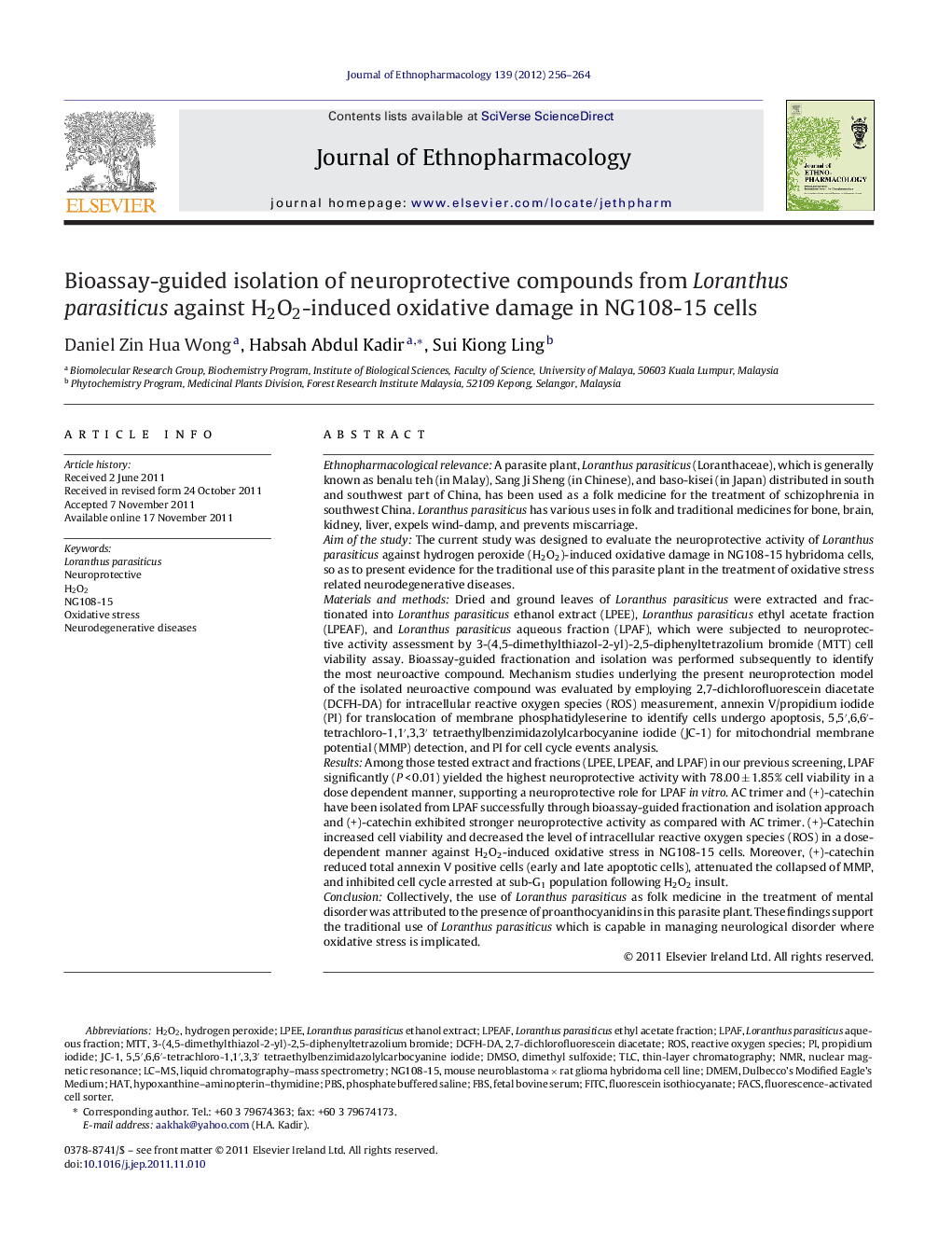| Article ID | Journal | Published Year | Pages | File Type |
|---|---|---|---|---|
| 5839140 | Journal of Ethnopharmacology | 2012 | 9 Pages |
Abstract
Ethnopharmacological relevanceA parasite plant, Loranthus parasiticus (Loranthaceae), which is generally known as benalu teh (in Malay), Sang Ji Sheng (in Chinese), and baso-kisei (in Japan) distributed in south and southwest part of China, has been used as a folk medicine for the treatment of schizophrenia in southwest China. Loranthus parasiticus has various uses in folk and traditional medicines for bone, brain, kidney, liver, expels wind-damp, and prevents miscarriage.Aim of the studyThe current study was designed to evaluate the neuroprotective activity of Loranthus parasiticus against hydrogen peroxide (H2O2)-induced oxidative damage in NG108-15 hybridoma cells, so as to present evidence for the traditional use of this parasite plant in the treatment of oxidative stress related neurodegenerative diseases.Materials and methodsDried and ground leaves of Loranthus parasiticus were extracted and fractionated into Loranthus parasiticus ethanol extract (LPEE), Loranthus parasiticus ethyl acetate fraction (LPEAF), and Loranthus parasiticus aqueous fraction (LPAF), which were subjected to neuroprotective activity assessment by 3-(4,5-dimethylthiazol-2-yl)-2,5-diphenyltetrazolium bromide (MTT) cell viability assay. Bioassay-guided fractionation and isolation was performed subsequently to identify the most neuroactive compound. Mechanism studies underlying the present neuroprotection model of the isolated neuroactive compound was evaluated by employing 2,7-dichlorofluorescein diacetate (DCFH-DA) for intracellular reactive oxygen species (ROS) measurement, annexin V/propidium iodide (PI) for translocation of membrane phosphatidyleserine to identify cells undergo apoptosis, 5,5â²,6,6â²-tetrachloro-1,1â²,3,3â² tetraethylbenzimidazolylcarbocyanine iodide (JC-1) for mitochondrial membrane potential (MMP) detection, and PI for cell cycle events analysis.ResultsAmong those tested extract and fractions (LPEE, LPEAF, and LPAF) in our previous screening, LPAF significantly (P < 0.01) yielded the highest neuroprotective activity with 78.00 ± 1.85% cell viability in a dose dependent manner, supporting a neuroprotective role for LPAF in vitro. AC trimer and (+)-catechin have been isolated from LPAF successfully through bioassay-guided fractionation and isolation approach and (+)-catechin exhibited stronger neuroprotective activity as compared with AC trimer. (+)-Catechin increased cell viability and decreased the level of intracellular reactive oxygen species (ROS) in a dose-dependent manner against H2O2-induced oxidative stress in NG108-15 cells. Moreover, (+)-catechin reduced total annexin V positive cells (early and late apoptotic cells), attenuated the collapsed of MMP, and inhibited cell cycle arrested at sub-G1 population following H2O2 insult.ConclusionCollectively, the use of Loranthus parasiticus as folk medicine in the treatment of mental disorder was attributed to the presence of proanthocyanidins in this parasite plant. These findings support the traditional use of Loranthus parasiticus which is capable in managing neurological disorder where oxidative stress is implicated.
Keywords
hypoxanthine–aminopterin–thymidinePBSNG108-15FACSNeuroprotectiveJC-1DMEMFBSDCFH-DATLCFITCnuclear magnetic resonance2,7-dichlorofluorescein diacetate3-(4,5-dimethylthiazol-2-yl)-2,5-diphenyltetrazolium bromideDMSOLC–MSDulbecco's modified Eagle's mediumMTTROSHydrogen peroxideNeurodegenerative diseasesNMROxidative stressDimethyl sulfoxidefetal bovine serumliquid chromatography–mass spectrometryPhosphate buffered salinefluorescein isothiocyanatefluorescence-activated cell sorterH2O2Propidium iodidethin-layer chromatographyHATReactive oxygen species
Related Topics
Health Sciences
Pharmacology, Toxicology and Pharmaceutical Science
Pharmacology
Authors
Daniel Zin Hua Wong, Habsah Abdul Kadir, Sui Kiong Ling,
